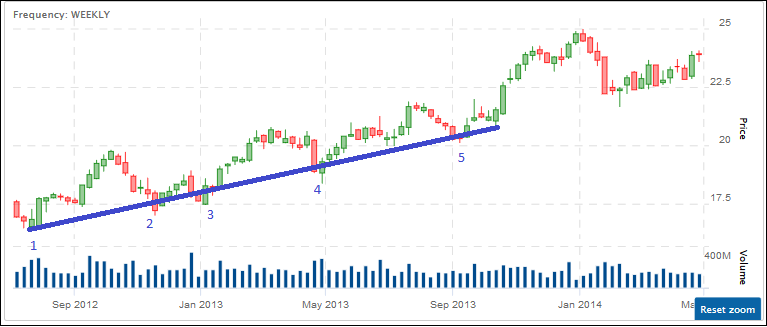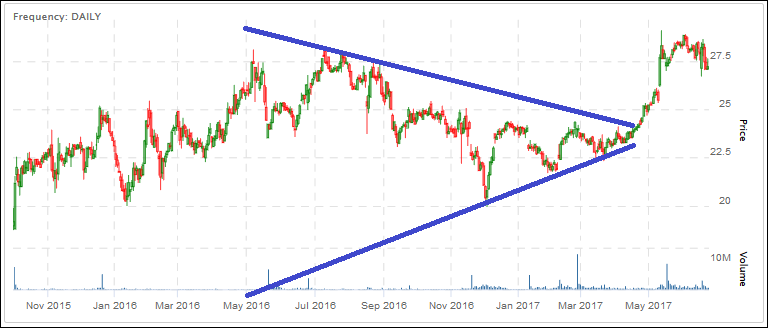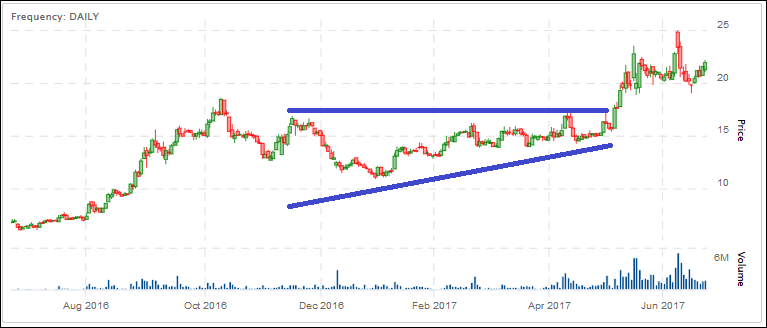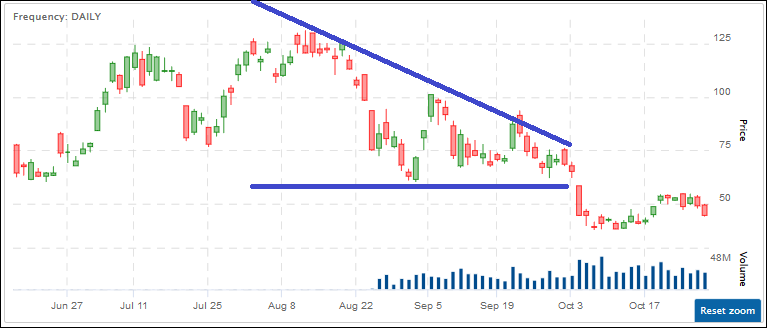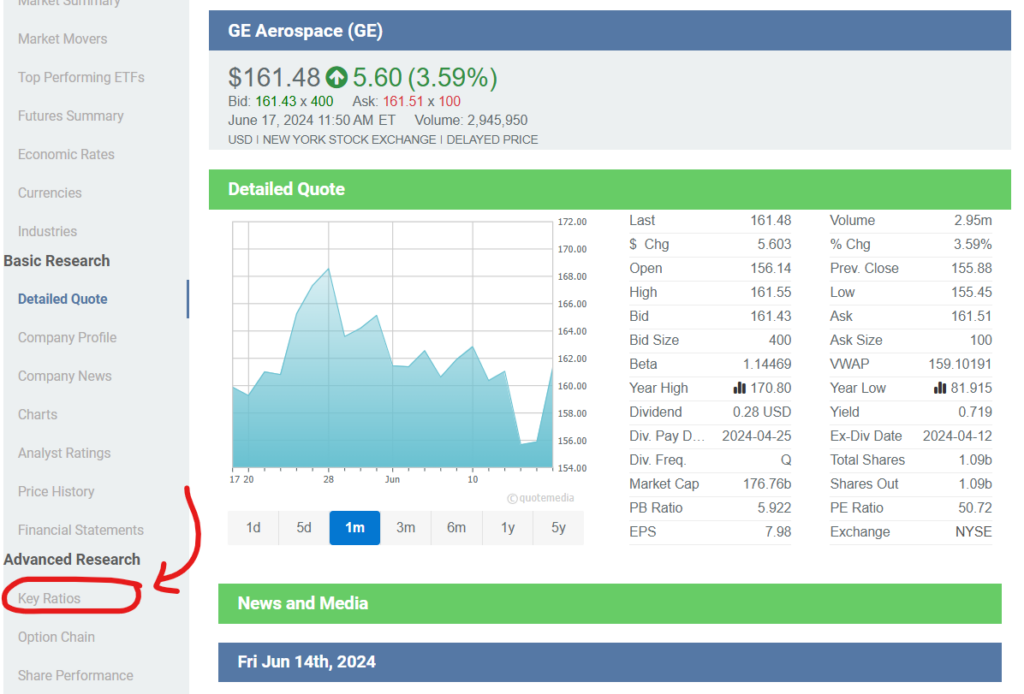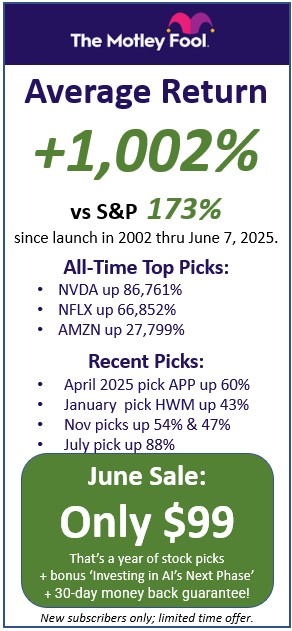How To Pick Stocks – The Basics
The most challenging aspect of starting to invest in the stock market is deciding what stocks to buy. Every experienced investor has his/her own techniques and strategies that they believe in. But when you are just getting started, learning how to pick stocks can be very challenging.
Here at HowTheMarketWorks, we want to give you the tools and confidence you need and show you how to buy stocks and make your first trades. This will help you get your portfolio off to a good start.
Getting Started
Remember, your HowTheMarketWorks account is virtual money! The point of using virtual money is to learn and practice, so just jump right in! You need to make a couple of trades on your virtual account just to see how easy it is to place trades. This will get your confidence up.
The first thing you need to know is all stocks have a unique code, or ticker symbol. Here are some popular stocks and their ticker symbols: Starbucks (SBUX), Walmart (WMT), Coca-Cola (KO), Netflix (NFLX), Amazon (AMZN), Apple (AAPL), Home Depot (HD), and Tesla (TSLA). When you go to make your first trade and enter a ticker symbol, you will see the price. So if your stock is at $50 and your buy 100 shares, it will cost $5,000.
Those are some of the most popular stocks. Now, if you want to get some other ideas from proven sources of the best stock picks in recent years, you can review these articles about the most popular stock newsletters. Each of these has a fee of about $100 for the first year, but since their recommendations have historically been very good and have beaten the market’s overall return, if you are considering investing your real money in the market these might be a good place to go.
For example, here are some of our reviews of the most popular stock market tools:
- This Seeking Alpha Review shows you their STRONG BUY rated stocks have beat the market year over year. Get Seeking Alpha premium for just $119 a year.
- This Motley Fool Review shows you the performance of their top Stock Advisor newsletter. Get their next 12 months of picks for just $79.
- Our Motley Fool Vs Zacks Comparison shows you which of these 2 top stock newsletters is best for you.
- Our Alpha Picks Review shows you this newest service is already beating the market by 20% in their first six months. Get the next year of Alpha picks for just $99.
- See which is the Best Stock Newsletter.
Before picking your first stock, the first step is deciding what your goals are for your portfolio.
Risk and Reward
The biggest choice you will make will be balancing risk and reward. Should you invest all your cash in very risky stocks with high growth (and loss) potential, or focus on companies that you believe can be strong in the long term?
Think of this risk and reward choice this way: Would you rather have an 10% chance of doubling your money (risky) or a 100% chance of making 10% on your money? The expected return of each of those choices is 10%, but in the first scenario 9 out of ten times you will make nothing.
Establish Goals
In order to reduce some risk in picking stocks, many first time investors will often ask their friends for stock tips. This is not a good idea. Investing in the stock market is not easy and you need to learn to do it correctly.
We recommend learning stock picking by reading how the professionals do it. One of the most popular stock advisory services is called The Motley Fool. This Motley Fool Review will explain how the Motley Fool team analyzes stocks to find what they believe are the best stocks to buy. Their stock picks over the last 4 years have beaten the overall market by at least 20% each of the last 4 years. They frequently run special offers on THIS PAGE available to new subscribers for a trial of just $19. It is well worth the money to get solid recommendations.
Diversification
Once you consider how risky you are feeling, next decide how you want to diversify your portfolio, which will help you decide how much cash to invest in each symbol. Your challenge may do this automatically – most challenges include a position limit, meaning you can only invest a certain percentage of your cash in any single stock. You can check if your contest has a Position Limit rule on the Account Balances page.
Once you establish the minimum number of securities you need, you can now start handpicking stock symbols by using a trading strategy. You can also create a mix of these strategies to get the best of each strategy.
Trading Strategies for Beginners
The goal of your trading strategy is to get a list of stocks or ETFs that you might want to invest in. The purpose is just to get a wish list of stocks – at the end of the day, you will probably add half (or fewer) of your initial picks to your permanent portfolio. Once we get that initial list of possibilities, we will take a look at how to narrow the list down.
“Invest in what you know” Strategy
The best way to start when buying stocks is to buy what you know, not trying to follow stock tips or read a bunch of technical analysis that you cannot follow. Think of it this way: if you already know a company, they have done well enough in the past to already become a household name today. This gives you, as the investor a big advantage; you can see how that company is doing just by looking at their stores and reading normal business news.
Ask yourself the following questions:
- Have they started to open new stores around me lately, or are they closing some shops?
- Does there seem to always be a lot of people you know using their products, or are they still more obscure?
- Do you find yourself using more of their services (giving them more money) month after month?
- Does their current news look positive or negative?
If all of these are positive, then this might be a good place to invest.
Earnings Strategy
An investor can always handpick stocks based on the earnings calendar. To do so, you would have to know your investment time horizons, and flip through the earnings calendar to find gems (i.e. stocks that you can buy and that will soar during its earning season, or stocks that will tank and that can be shorted beforehand).
The Earning Strategy is somewhat of an evolution of the “Invest in what you know” strategy – you will be looking for companies that you believe will have high earnings announcements coming up soon, which can cause their stock price to rise.
Once you have found your stocks, it’s very important to analyze them and back-up your assumption of how the market will react to their earnings report.
An example of a well executed trade based on the earnings’ expectations would be Nvidia (NVDA). Before the presentation, NVDA was trading around 102 and soared continuously ever since to 139.67 on the 20th of June 2024!
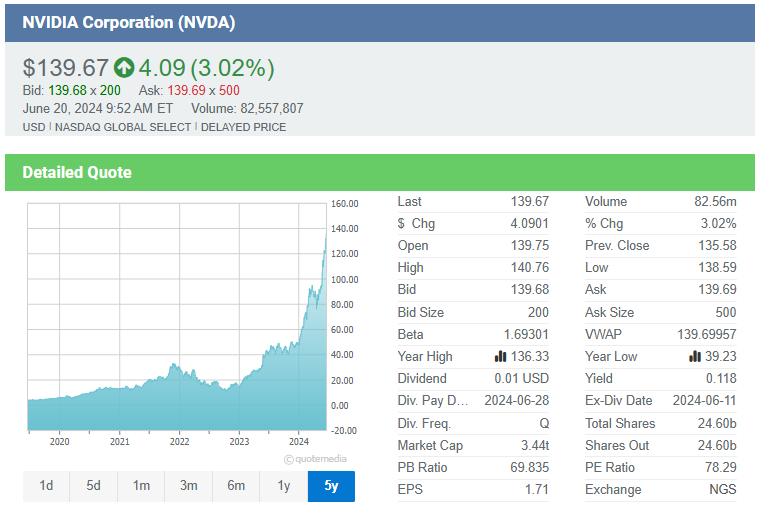
You can compare with other stocks with recently-released earnings using our Quotes Tool.
Buy the Best Stock Newsletter to Get Their Stock Picks
As mentioned earlier, we track many stock newsletters and the best one for the last 4 years has been the Motley Fool Stock Advisor. It’s average pick for the last 4 years is up 74.63%. Not all of their picks are winners. They just have a very good record of picking a few stocks that double or triple each year so these winners more than offset a few losers. You can try their service for just $19 if you CLICK HERE so it is an excellent place to start. It is well worth the money to get solid stock picks.
If you want a more thorough review of their best selling newsletter then our Motley Fool Stock Advisor Review will tell you about their most popular advisory service, how it has performed in the last 4 years, and give you a 50% discount if you want to try it. If you still aren’t convinced, then read this review of the top stock newsletters.
The Passive strategy
If you are not sure which specific stock to select, you can always invest in ETFs and market indices. These products are already diversified and will track a specific market for you.
The most popular ETFs are the ones that match the most popular indices: Dow Jones Industrial Average (DIA), S&P500 (SPY), Nasdaq (QQQ). Starting your portfolio with either or all of these is often the best place to start.
ETFs come in specific industries too. As an example, let’s say you want to invest in a gaming company, but don’t know which company in specific. You can always invest in an ETF that will track the gaming market for you. In this situation, you can invest in the Amplify Video Game Tech ETF (GAMR), which tracks this market for you. They have invested in various aspects of video game technology, like game developers, retailers and console or chip manufacturers. This means the stock picking and allocation tasks has been already taken care of by the Fund Managers of this ETF.
You can find a specific ETF from etf.com: The Best ETF Screener | etf.com
Many investors also start with a passive strategy, and slowly break out. This would mean starting your portfolio by picking ETFs in 5 industries you want to invest in, then looking at each of those industries in detail using some of the other strategies here. Once you identify some stocks within those industries, you can sell off some of the ETF holding, and use the cash to invest in the stocks you have researched.
Stock Screeners Strategy
You can also use stock screeners to find good purchases and short sales. A Stock Screener is a program or website that will ask you some questions about what you are looking for in a stock, and return a list of stocks that match your criteria. You can then do extra research on these stocks to determine if they should be added to your portfolio.
Getting Trading Ideas
We also have a Trading Ideas page that will help you review the overall market’s health and help you adjust your stock picks.
The Research pages on HowTheMarketWorks have the following information:
Today’s Market Summary
The Market Summary page is very useful for the start of your research. It presents the day’s market summary. It is useful because it tells you how the overall market is doing today. As an example, on May 17th, 2017, you would notice that indices such as SPY dropped 5 points due to the “Trump-Russia” investigation. This can be used as a signal to certain investors to buy more. If an investor purchased SPY during the dip, he/she would have gained more than $5 per share! It’s important to review how the overall market is doing and the market news each day. This can help you to capture the perfect timing to buy stocks at their lowest price (or to short sale them at their peak).
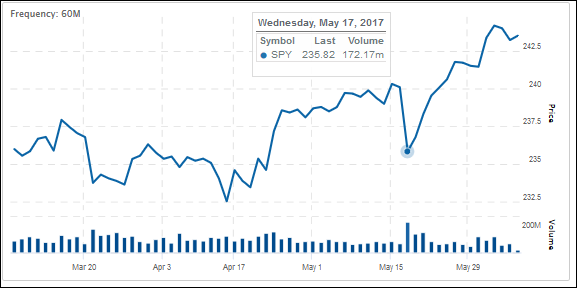
Earnings Release
The Earnings Release page presents a stock’s quarterly earnings pre-announcements with the current estimate and new range. A stock’s volatility increases when it is near the earnings report.
Analyst Ratings:
The Analyst Ratings page presents the recommendations given by brokerage firms and financial analysts. This page will be useful to analyze a stock’s recommendation trend and the current average recommendation.
Best/Worst Exchange-Traded-Funds (ETFs)
Looking for an Exchange-Traded Fund? The Top Performing ETFs page is a great place to see which ETF is currently doing well and which is not. This can signal current market trends and help you make choices based on that.
Picking Stocks – Intermediate Analysis
Now that you have a couple of stocks in mind, you should perform a more advanced analysis of your selection. This extra step of your research will be useful for two major reasons:
- You will verify if these stocks are truly good investments. They can be rejected if you discover there has been a lot of hype, but the company is not actually doing well.
- You will back up your assumptions about these stocks. If your classmates or teacher have any questions about the reasoning behind your choices, you will be able to provide a robust and solid argument.
This is where you can choose the stocks that actually go into your portfolio for the long-run. If you started with a passive strategy, your portfolio might already have some industry ETFs, but now we will be looking at specific companies to replace part of those investments.
We will explore a couple of basic research methods that will complement your findings.
Technical Analysis
Technical analysis is the process of determining patterns and trends with the use of historical data for a security and charts of a specific timeframe. Charts are clearly an efficient way to visually notice a pattern and act upon a specific trend. We will visit a couple of basic chart patterns and put them in real-life contexts as well. Most of the technical analysis tools make use of the charts you can find in the Quotes Tool.
Trends & Trend lines
A trendline is a straight line that connects the stock’s price movement together and creates an upward or downward pattern. It is often recommended to connect more than 2 points to have a stronger trend line.
Trendlines are useful to give you a general idea of how a stock’s price is generally moving. A positive trendline does not mean it will keep going up forever, but can be an indication that there are some strong underlying business foundations.
Support & Resistance
A support line represents a price level at which the stock never went below. In other words, it is the point at which the stock struggles to go under. On the other side, a resistance line represents the price level for which the stock cannot breakthrough.
Stocks near their support lines tend to rebound, so they might make a good investment (at least in the short term). Stocks near their resistance line tend to fall back down, so they might signal a shorting opportunity.
When a stock breaks through their support or resistance lines, it is called a breakout.
Symmetrical Triangle
This pattern consists of two trend lines which are symmetrical to the horizontal and are convergent. To prove a symmetrical triangle, one must have oscillation between the two lines.
A triangle pattern indicates that the price is about to move – but a symmetrical triangle does not give a clear indication that the price will go up or down.
Ascending Triangle
The Ascending Triangle pattern refers to two converging trend lines. The first line is an upward slant which is the support and the other is a horizontal resistance line. To validate the ascending triangle, there must be an oscillation between the two lines.
This triangle implies a bullish continuation pattern.
Descending Triangle
The Descending Triangle pattern refers to two converging trend lines. The first line is an downward slant which is the support and the other is a horizontal resistance line. To validate the ascending triangle, there must be an oscillation between the two lines.
This triangle implies a bearish continuation pattern.
Fundamental Analysis
Fundamental analysis is the process of examining the fundamental aspects of a firm. It involves reviewing a company’s financial statements, like their income statement, cashflow statement and balance sheet, to define its health and attractiveness. Since financial statements are standardized between companies, this can help compare two potential investments apples-to-apples.
Warren Buffet famously said, “Never invest in a company you cannot understand.” What he meant was to read the company’s balance sheet, and their other financial statements. Study the role they play in their industry so that you understand how they operate. Keep track of any changes to their dividend yields. All of this is part of fundamental analysis.
You can directly find most of the ratios by clicking on Key Ratios in the Quotes Tool.
One of the most popular and simple fundamental analysis is the DuPont Model. The DuPont Analysis breaks down the firm’s Return on Equity (ROE) based on its profitability decisions, how efficiently their assets are utilized and their financial leverage. The model focuses on the profitability of a firm using the following equation:

This equation can be re-written as:

To analyze a company using the Dupont Model, you can use the following tables:
Analysis of Company XYZ from 2014 to 2017
| DuPont Model Components | 2020 | 2021 | 2022 | 2023 |
| Net Income | ||||
| Equity | ||||
| Net Sales | ||||
| Average Total Assets | ||||
| Average Shareholders’ Equity | ||||
| Profit Margin | ||||
| Asset Turnover | ||||
| Equity Multiplier | ||||
| ROE |
Analysis of Company XYZ with Industry Competitors
| DuPont Model Components | Company XYZ | Company A | Company B |
| Net Income | |||
| Equity | |||
| Net Sales | |||
| Average Total Assets | |||
| Average Shareholders’ Equity | |||
| Profit Margin | |||
| Asset Turnover | |||
| Equity Multiplier | |||
| ROE |
These tables will allow you to see the evolution of the firm in terms of their profitability. This can be useful for analyzing whether a company will be profitable over the long-term or if this is a growth stock that will soon reach its zenith. You will also have the bird’s eye view of the business and its competitors in the same industry. By doing this, you might find a competitor that would be a better stock pick or reassure yourself that your stock pick is the best in its category.

